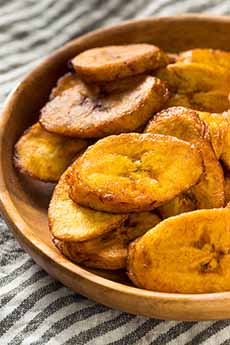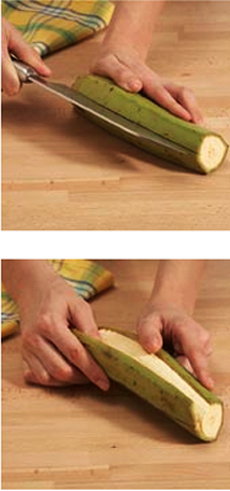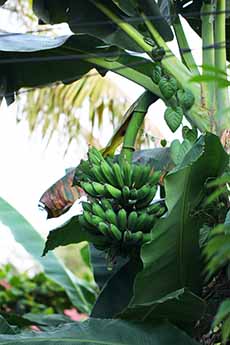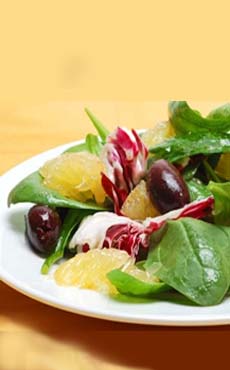|
If you’ve never cooked with plantains before, today—Cinco de Mayo—is the day to try it—ideally, our favorite, fried plantains (photos #1 and #2).
You may have enjoyed a bag of plantain chips—we love them. But a batch of hot fried plantains is its own delicious experience.
While yellow-brown, brown and black plantains can be peeled like a banana, it is much more difficult to peel a green or yellow plantain.
Instead, take a paring knife, slice off the ends of the plantain and slit the skin lengthwise. If the plantain is very long, you can cut it in half or in thirds before you slit the skin (photo #3).
Then, simply slide your thumbnail under the slit and pry off the skin.
What to do with your plantains?
If you like French fries and fried zucchini, make fried plantains.
> Check out the history of plantains, below.
RECIPE: FRIED PLANTAINS
For the best fried plantains, choose plantains with skin that is dull yellow with patches of black, or completely black. This is when the plantains are at peak ripeness.
Ingredients
Ripe plantains
Vegetable oil
Salt and pepper to taste
Optional seasonings: chipotle, garlic salt, grated cheese, or other favorite
For serving: ketchup or other condiment
Preparation
1. CUT the plantains into 1/8″ slices. Add vegetable oil 1-1/2 inches deep in a large skillet and heat to 375°F.
2. FRY the plantains for 1 minute or more on each side until golden and crisp on the outside, but soft on the inside, for a total of 2-3 minutes. Remove with a slotted spoon and drain on paper towels.
3. SEASON as desired and serve while hot.
THE HISTORY OF PLANTAINS
Plantains are believed to have originated in Southeast Asia.
Archeologists have focused on the Kuk valley of New Guinea around 8000 B.C.E. as the area and time where man first domesticated the banana or the plantain—they are the same species and the subspecies can’t be determined.
The fruit was also domesticated in other areas of Southeast Asia and the South Pacific between 8000 B.C.E. and 5000 B.C.E. Here’s the path of its journey around the world.
Plantains and bananas are now grown in Africa, the American tropics, Egypt, India, Indonesia, and the islands of the Pacific.
Not A Tree, But An Herb
Although they look like trees (photo #4), banana and plantain plants do not have a woody trunk.
Their base is made of huge leaf stalks—a conical false “trunk” formed by the leaf sheaths of long spirally arranged leaves.
They are technically giant herbs!
These giant herbs spring from an underground stem, or rhizome. Most varieties grow 10–33 feet tall (3–10 meters).
The fruits grow in bunches, and like bananas, are green when picked and ripen into yellow, then brown-speckled yellow.
Plantains are a staple in many areas of the world. They are in the same genus (Musa) as sweet bananas.
Globally, plantains account for about 85% of all banana cultivation worldwide [source].
Cooking Bananas (Plantains) Vs. Dessert Bananas (Sweet Bananas)
Sweet bananas are referred to as dessert bananas, while plantains are referred to as cooking bananas.
Plantains are more firm and lower in sugar, and thus ready to be steamed, boiled, or fried.
Plantains have more starch than the dessert bananas and are not eaten raw. Because plantains contain the most starch before they ripen, they are usually cooked green—either boiled or fried, and served with other savory dishes.
Ripe plantains are mildly sweet and are often cooked into a sweet dish with coconut juice or sugar as a flavoring.
Plantains can be dried for later use in cooking or ground for use as a meal, which can be further refined into flour.
In some parts of East Africa (notably in central and eastern Uganda and Tanzania), the plantain is an important beer-making crop.
Dessert bananas are eaten raw and made into desserts such as ice cream, pie, and sautéed bananas (like Bananas Foster).
|
|

[1] Fried plantains, a delicious side instead of potatoes (photo © Panther Media | Bhofack2).

[2] Serve them as the starch component of meals (photo © Picha | Pexels).

[3] The trick to peeling plantains is to cut a long slit and pull the peel apart (photo © Melissas’s Produce).

[4] It may look like a tree, but plantains are a giant herb (photo © Esperanza Doronila | Unsplash).
|






